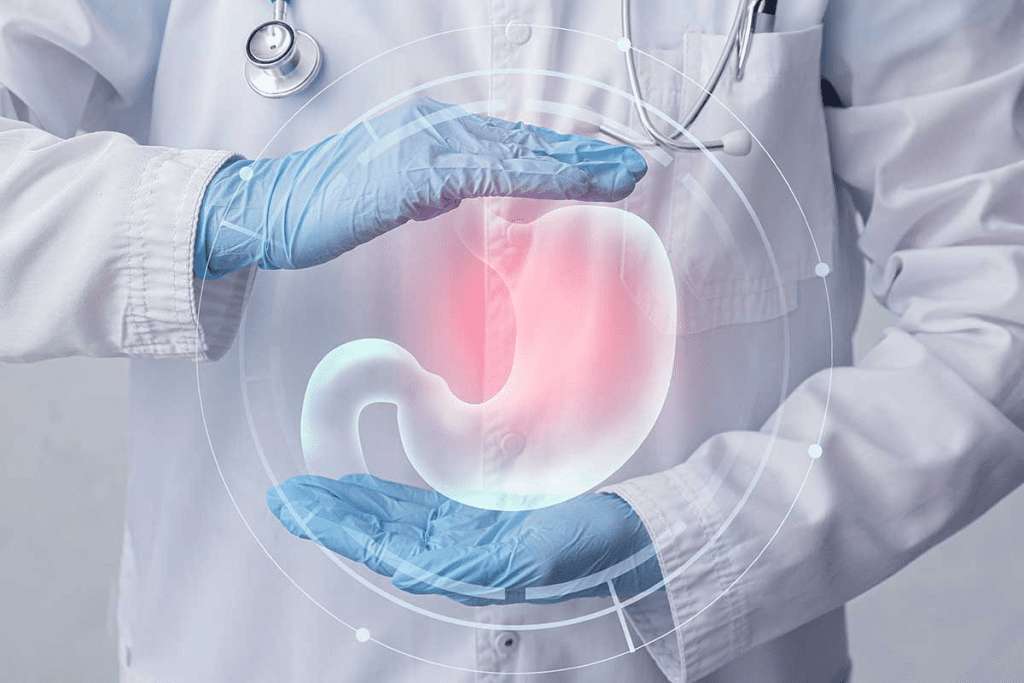Last Updated on November 14, 2025 by
Functional gastrointestinal disorders (FGIDs) are a big health problem worldwide. They affect up to 40% of people globally. These disorders make daily life hard and lower the quality of life for millions. Gastrointestinal symptoms that can’t be explained by other health issues define these disorders.
Irritable bowel syndrome (IBS) is the most common FGID. We will look at how this condition affects people and the challenges in diagnosing and treating it. It’s important to understand FGIDs to help those affected. Functional gastrointestinal disorders (FGIDs) are a big health problem worldwide. They affect up to 40% of people globally. These disorders make daily life hard and lower the quality of life for millions.
Gastrointestinal symptoms that can’t be explained by other health issues define these disorders.

Functional Gastrointestinal Disorders (FGIDs) are a group of conditions that can’t be explained by other diseases. They cause ongoing or recurring symptoms in the stomach and intestines. These symptoms can really affect a person’s quality of life.

FGIDs are diagnosed using the Rome IV criteria. This criterion helps doctors classify these disorders. It looks at how long and often symptoms last, and makes sure other diseases aren’t causing them.
Key aspects of the Rome IV criteria include:
FGIDs are divided into several types, such as functional dyspepsia and irritable bowel syndrome (IBS). Each type has its own set of criteria based on the symptoms it causes.
FGIDs are very common all over the world. They affect a lot of people of all ages and in different places. The exact prevalence of each FGID varies by region and population, but collectively they represent a significant health burden.
FGIDs are among the most common stomach and intestine problems seen by doctors. Their widespread occurrence shows we need to be aware and find good ways to manage them.
“The high prevalence of FGIDs worldwide highlights the importance of a thorough approach to diagnosis and treatment, considering the complex mix of physical, mental, and environmental factors.”
Expert in Gastroenterology
FGIDs are a big challenge for healthcare systems. They need a team effort to meet the complex needs of those affected. By understanding FGIDs better, we can work on better ways to manage them.
Functional dyspepsia is a common condition that causes ongoing pain or discomfort in the upper stomach. It greatly affects people’s lives, making it key to know its causes, symptoms, and how it’s diagnosed.
Functional dyspepsia is a type of FGID that leads to chronic upper stomach pain or discomfort. It’s diagnosed using the Rome IV criteria. These criteria include symptoms like epigastric pain, early feeling full, and discomfort after eating.
The symptoms of functional dyspepsia differ from person to person. They often include:
To diagnose functional dyspepsia, doctors look for these symptoms. They need to be present for at least 3 months. The symptoms must start at least 6 months before the diagnosis.
Functional dyspepsia is a very common FGID, with a global prevalence estimated to be around 10% to 20%. This high rate shows the need for more awareness and understanding of the condition.
Several factors can increase the risk of developing functional dyspepsia. These include:
Knowing these risk factors and triggers is important for managing functional dyspepsia effectively.
Functional constipation is the second most common FGID. It causes persistent or recurring constipation symptoms. These symptoms greatly affect the quality of life for those who have it.
Functional constipation is a type of FGID. It involves constipation symptoms without a clear cause. We will look at what makes up this condition.
To diagnose functional constipation, certain criteria must be met. These include symptoms like infrequent bowel movements and straining. The symptoms must last a certain amount of time and happen often enough to qualify for a diagnosis.
Common symptoms include:
Functional constipation is a common FGID, affecting approximately 10-15% of the global population. It’s a big health issue. The number of people affected can change based on many factors.
It’s important to tell functional constipation apart from Irritable Bowel Syndrome with Constipation (IBS-C). While both have constipation, IBS-C also includes recurrent abdominal pain. We need to look closely at symptoms and criteria to give the right diagnosis and treatment.
Understanding the differences between these conditions is key. It helps us give the best care to those with gi disorders symptoms and functional gi disorders.
Irritable Bowel Syndrome (IBS) affects millions worldwide, causing discomfort and disrupting daily life. It’s a complex disorder that changes bowel habits and causes pain. This greatly impacts patients’ quality of life.
IBS is a disorder without clear signs, diagnosed by symptoms. It involves gut motility, hypersensitivity, stress, and psychosocial factors. This makes it a complex condition.
IBS is more than a condition. It’s a mix of physical and mental factors needing a full management plan.
IBS has several subtypes based on bowel habits: IBS-C, IBS-D, IBS-M, and unsubtyped IBS. Knowing these subtypes helps tailor treatments to each patient.
IBS affects approximately 10% to 15% of the global population, making it the most prevalent FGID. In the U.S., it’s a big reason for healthcare visits and work absences. It has a big impact on both people and healthcare systems.
Diagnosing IBS involves clinical evaluation, symptom assessment, and ruling out other disorders. The Rome IV criteria are used, focusing on recurrent abdominal pain and bowel habit changes.
Key diagnostic steps include:
Understanding IBS helps us manage it better. We focus on symptom relief, improving quality of life, and addressing the complex factors involved.
It’s important to know how Functional Gastrointestinal Disorders (FGIDs) affect different groups of people. These disorders are influenced by many factors. This makes them more common in some groups than others.
FGIDs are more common in women than in men. This is true for many FGIDs, like Irritable Bowel Syndrome (IBS) and Functional Dyspepsia. Hormones, genes, and social factors all play a role in this difference.
Women are more likely to notice and talk about their FGID symptoms. They also seek medical help more often. This shows we need to treat FGIDs with a focus on gender.
FGIDs can occur at any age, but they are often diagnosed in young to middle-aged adults. The prevalence can decrease in older age groups, but it is still a common problem. This suggests that lifestyle and stress in younger years might cause FGIDs. As people get older, FGIDs might become less common. This could be because of lifestyle changes or how they handle stress. But it’s important to keep managing symptoms in all age groups.
FGIDs vary a lot by region and culture. How people report and experience symptoms can differ a lot. This is because of the cultural background and environment.
In some Western countries, FGIDs are more common than in Eastern cultures. This might be because of diet, lifestyle, and how people seek medical help. It’s key to understand these differences to treat FGIDs better.
Genes and environment both play a big role in FGIDs. If your family has FGIDs, you’re more likely to get them. This shows a genetic link.
Things like diet, stress, and lifestyle also affect FGIDs. The mix of genes and environment makes FGIDs complex. This means we need a full approach to manage them.
Knowing how FGIDs affect different people helps doctors treat them better. This can lead to better health outcomes for patients.
Managing functional gastrointestinal disorders (FGIDs) needs a mix of treatments. We’ll look at how to ease symptoms and improve life for those with these conditions.
Changing lifestyle and diet is often the first step. These changes can help manage gi disorders symptoms and lessen flare-ups. Keeping a food diary to track trigger foods is recommended.
Adding more fiber, avoiding certain foods, and drinking plenty of water are good starts. A diet full of fruits, veggies, and whole grains can help with bowel movements. Staying active and at a healthy weight also supports gut health.
When diet and lifestyle changes aren’t enough, medicines might be needed. Laxatives, antispasmodics, and anti-diarrheal drugs can help with specific gi disorders symptoms. For example, laxatives help with constipation, and antispasmodics ease IBS pain.
A study on the National Center for Biotechnology Information (NCBI) website shows medicines can be effective. Working with a healthcare provider to find the right medicine is key
Psychological therapies like CBT and gut-directed hypnotherapy are helpful. They help manage the emotional side of FGIDs, reducing stress and anxiety that worsen symptoms of digestive disorders.
These therapies can improve overall well-being. Talking to a healthcare professional about these options is a good idea.
New treatments for FGIDs are being researched. Probiotics, prebiotics, and other microbiome-focused treatments are being explored. These aim to balance the gut microbiome and lessen symptoms.
As we learn more about FGIDs, better treatments will emerge. Keeping up with the latest research is important for both patients and healthcare providers.
Managing functional gastrointestinal disorders (FGIDs) needs a team effort. We’ve talked about how common and impactful FGIDs are. This includes issues like functional dyspepsia, constipation, and irritable bowel syndrome.
Looking ahead, we must keep finding new ways to help patients. This means making lifestyle changes, using medicine, and trying psychological therapies. Doctors and healthcare teams are key in managing these conditions. They should focus on what each patient needs.
The path forward for FGID management is teamwork. Healthcare experts, researchers, and patients must work together. This way, we can better understand and treat gastrointestinal issues. It will help improve life for those dealing with these health problems.
FGIDs are a group of disorders. They cause persistent or recurring gastrointestinal symptoms. These symptoms can’t be explained by structural or biochemical abnormalities.
Irritable bowel syndrome (IBS) is the most common type of FGID, affecting an estimated 10% to 15% of the population worldwide.
Symptoms of functional dyspepsia include persistent or recurring pain in the upper abdomen. It’s often accompanied by bloating, nausea, and vomiting.
IBS is diagnosed using the Rome IV criteria. This includes recurrent abdominal pain or discomfort and changes in bowel habits. Other symptoms like bloating and changes in stool characteristics, are also considered
IBS involves abdominal pain or discomfort and changes in bowel habits. Functional constipation is mainly about difficulty passing stools or infrequent bowel movements.
Yes, FGIDs, including IBS and functional dyspepsia, are more common in women. The reasons for this gender difference are not fully understood.
Treatment for FGIDs includes lifestyle and dietary changes, pharmacological interventions, and psychological therapies. Emerging options like gut-directed hypnotherapy are also available.
While there’s no cure for FGIDs, a management plan can help alleviate symptoms. This improves the quality of life for patients.
Dietary factors, like food intolerances, can trigger or worsen FGID symptoms. Changing diet can be an effective management strategy.
Stress can make FGID symptoms worse. Stress management techniques, such as cognitive-behavioural therapy, can help manage these conditions.
Research suggests genetic factors may contribute to FGIDs. The exact mechanisms are not yet fully understood.
Irritable bowel syndrome (IBS) and functional dyspepsia (FD) are very common FGIDs. We will look at how these conditions affect people and the challenges in diagnosing and treating them. It’s important to understand FGIDs to help those affected.
Subscribe to our e-newsletter to stay informed about the latest innovations in the world of health and exclusive offers!